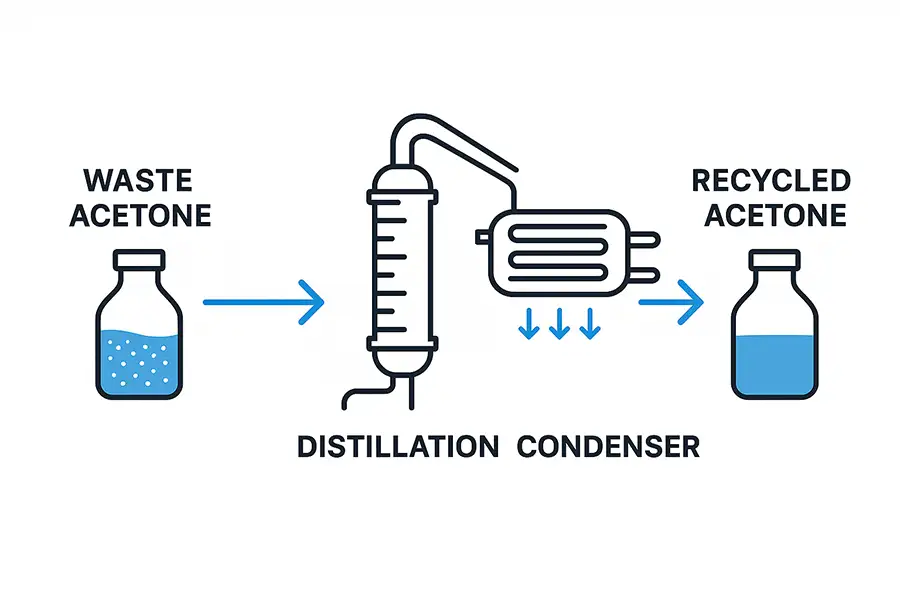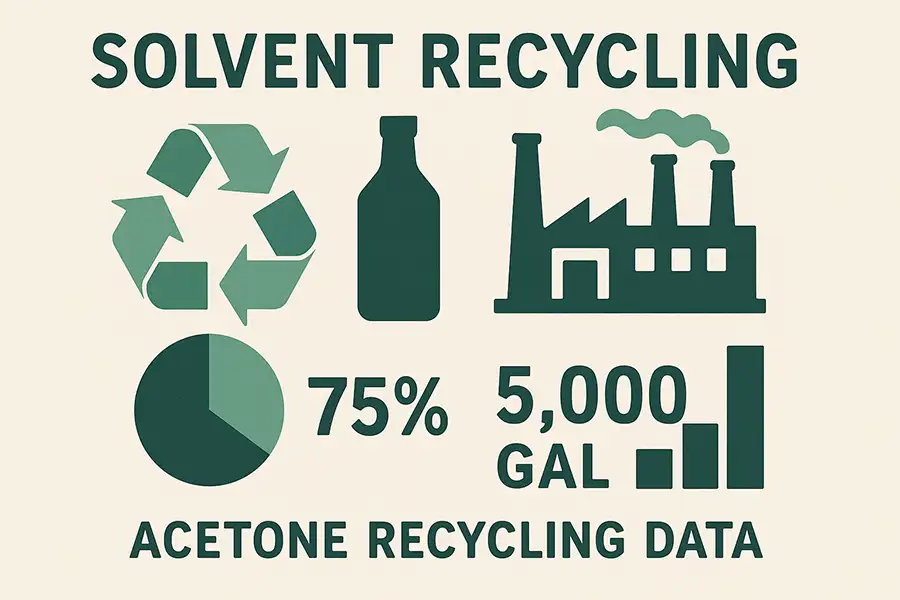Solvent Recycling Acetone
A Complete Guide to Cost Savings & Sustainability
Acetone is one of the most widely used solvents in industries ranging from manufacturing and automotive to pharmaceuticals and cosmetics. However, frequent disposal of used acetone is not only costly but also harmful to the environment. This is where solvent recycling acetone comes in — a process that allows businesses to reclaim and reuse acetone, saving money and reducing waste.
Turns harmful waste into reusable resources
What is Solvent Recycling?
Solvent recycling is the process of cleaning and purifying used solvents so they can be reused. For acetone, this typically involves distillation — heating the solvent until it vaporizes and then condensing it back into liquid form, leaving behind contaminants.
According to the U.S. Environmental Protection Agency (EPA), recycling solvents can reduce hazardous waste by up to 90%.

How Does Acetone Recycling Work?
The most common method for acetone recycling is distillation using a solvent recycling system. Here's the step-by-step process:
Collection
Used acetone is collected in a storage container for processing.
Heating
The solvent recycler heats the acetone until it vaporizes.
Condensation
The vapor is cooled back into high-purity liquid form.
Separation
Contaminants remain in the boiling chamber while clean acetone is collected.

Modern machines, like the solvent recycler machine, are designed to be easy to operate, energy-efficient, and capable of handling various solvent types beyond acetone.
Benefits of Recycling Acetone
- Cost Savings: Reduce purchase costs by 50-80%
- Environmental Impact: Lower hazardous waste generation
- Regulatory Compliance: Meet EPA and local regulations
- Operational Efficiency: Continuous clean solvent supply
Industry Data and Trends
The solvent recycling market is rapidly growing under pressure from both environmental regulations and cost saving pressures:
Industry Growth
Global solvent recycling expected to grow at 5.8% CAGR from 2023-2028.
Waste Reduction
Adopting sustainable tech including solvent recycling could reduce operational waste by 40% by 2030.
Regulatory Influence
Over 85% of industrial businesses are adapting to stricter EPA regulations.

Comparison: New Acetone vs. Recycling
| Factor | Buying New Acetone | Recycling Acetone |
|---|---|---|
| Cost per Gallon | $15–$25 | $3–$5 |
| Annual Cost (1500 gal) | $30,000–$37,500 | $4,500–$7,500 |
| Environmental Impact | High waste generation | Low waste generation |
| Material Sustainability | Limited resources used | Closed-loop solution |
| Regulatory Compliance | More requirements | Simplified compliance |
| ROI Timeline | Not applicable | 6-12 months |
Compare Costs for Your Business
Choosing the Right Recycling Equipment
When selecting a solvent recycler, consider capacity, energy efficiency, ease of operation, and compatibility with multiple solvents:
Basic Recycler
Capacity: 5-20 gallons
Suitable for small labs
Single-solvent processing
Simple operation
Advanced Systems
Capacity: 20-100 gallons
Manufacturing facilities
Multi-solvent compatibility
Automated controls
Energy recovery systems
Conclusion: The Future is Recycling
Solvent recycling acetone is essential for any business using acetone regularly. By investing in solvent recycling equipment, companies can achieve significant cost savings, support sustainability goals, and ensure regulatory compliance. In a circular economy, recycling isn't just smart — it's essential.
